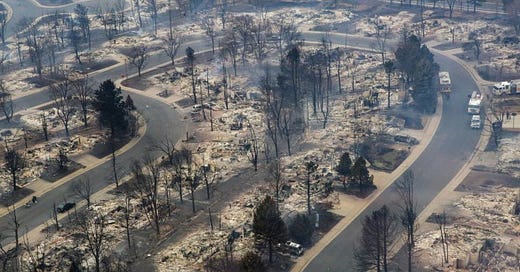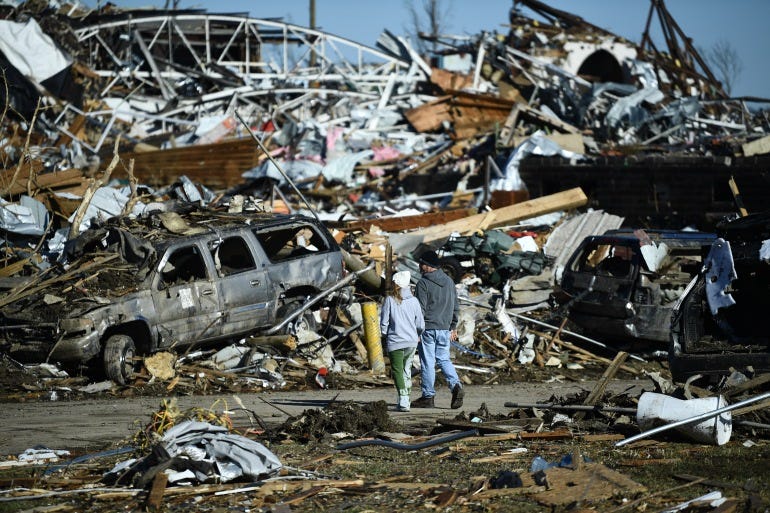Climate change and housing bubbles
As home insurance gets repriced to accurately reflect climate risks, look out
The second and third order effects of climate change aren’t limited to civil wars, humanitarian disasters, and rising authoritarianism, they also include more mundane impacts that can nevertheless crush people financially. One of these second order effects is increases in home insurance premiums in climate-vulnerable places to accurately reflect the heightened risk of property damage.
[I’m ignoring flood insurance today, which is not included in most home insurance policies. It’s a slightly more complicated topic because of a wonky and changing system of federal subsidies. But I’ll definitely come back to it in the future because flooding is the most common and most expensive category of natural disaster.]
The property insurance business is pretty simple: you charge many people modest amounts of money each month, and pay out money for repairs to those whose car/house/etc. gets damaged. It’s a system that spreads the risk of unlikely but expensive misfortune across a large number of people.
Every business needs its revenues to exceed costs. For insurance, that means (number of customers * average premiums) has to be greater than (instances of property damage * average cost of property damage).1
Looking at the second half of that equation, we see insurance costs are the number of instances of property damage times the average cost of damage. And what is climate change doing? It’s damaging more property in more places every year, and tending to cause more extensive damage on average.
As the equation shows, as costs rise premiums must rise, as well.
As wildfires, hurricanes, tornados, and other climate change-intensified weather disasters drive insurance companies’ costs higher, they will respond by raising the premiums they charge their customers. Premium increases will be concentrated in the places climate change has increased the risks of property damage the most. This has already started to happen, as Marketplace reported in 2020:
There was a moment in 2016, just after putting an offer on a house in the Oakland Hills in California, that Jamye Alexandra wondered if it was a mistake. Not because of the house itself, or the location, but because the insurance company the previous owners had been with for years said they would not keep insuring the property. There were too many trees, they said. Too much risk of wildfire. That made her pause.
“I was pretty nervous,” she said. “But since we were able to find a couple other insurance partners who were willing to do it, I wasn’t too worried.”
They went ahead and bought the house.
The next year, 2017, was one of the worst fire years in California history. Over a million and a half acres burned, and more than 10,000 structures were damaged or destroyed, more than in the previous 9 years combined. None of the fires were in Oakland, but even so, the following year, Alexandra and her husband got a notice from their insurance company: they were not renewing their policy. After that, the only option their broker could find them on the traditional market was nearly $13,000 a year — almost four times what they had been paying.
Since the insurance business is all about correctly estimating risks, one might assume the repricing of premiums to accurately reflect the increasing risk from climate change has already happened, or is happening in real time. But according to Vox, this is often not the case:
[E]ven as a sector focused on anticipating risk, insurance isn’t yet ready for the full consequences of climate change that lie ahead, which could harm both insurers and their customers.
There are various reasons for this. From the Washington Post:
Although insurance companies are filing rate increases to keep up with rising costs, they are being held in check somewhat by state regulators. California is a case in point. Although the state has been ravaged by wildfires, homeowners insurance premiums haven’t kept pace with increasingly expensive claims.
“There are some constraints with how quickly insurers can adjust their rates,” Collins said. “You may have some [states] who haven’t experienced the same amount of rate increases simply because the carriers are still in that process of a negotiated filing that is getting drawn out for a lengthy period of time.”
It’s not surprising that politics-influenced state insurance regulators might slow-walk rate increases that voters will hate. But regulators and outdated insurance company risk models won’t keep home insurance rates artificially low forever. Eventually they will reflect the actual, rising risk to homes.
The takeaway is clear and troubling: more home insurance premium increases are coming. This has serious financial implications for homeowners in climate-vulnerable areas where insurance premiums don’t yet reflect the true risk.
To get a sense of the financial consequences of insurance premium repricings, let’s consider two hypothetical homes, Home A and Home B, both on the market for $750,000. Home A is in a climate vulnerable place where home insurance premiums haven’t yet been repriced to reflect the risk. Home B is in a place that’s less vulnerable to climate change and where current insurance premiums are still a fairly accurate reflection of the potential for damage to homes.
Let’s say Person A buys Home A and Person B buys Home B, both for the asking price of $750,000. They both put down 20% ($150,000) and both borrow the remaining $600,000 at a fixed interest rate of 3.5% over 30 years. Both pay $1,000 per month in property taxes and $300 per month for homeowners insurance, so both have the same total monthly payment amount:
Mortgage payment: $2,694 ($600,000, 3.5% fixed, 30 years)
Property taxes: $1,000
Homeowners insurance: $300
Total: $3,994 per month
This number, $3,994 per month, represents what Homes A and B are worth; it’s the $750,000 sale price translated into a monthly amount. The market value for both Home A and Home B is $3,994 per month, and given tax and insurance payments of $1,300 per month, that leaves $2,694 for the mortgage payment.
Now let’s say the provider of insurance for Home A does a new risk assessment and determines the home insurance premiums don’t reflect the actual risk to the home. To bring the premiums in line with the risk, the insurance company raises Person A’s rates from $300 per month to $1,000 per month.
Increased home insurance rates are usually discussed in terms of the additional cost burden on the homeowner, which is obviously a critical perspective. But what I want to know is: how much can Person A now sell Home A for if they decide to move?
We established Home A is worth $3,994 per month. When Person A bought Home A, only $1,300 of the total amount was taxes and insurance, but now taxes and insurance have increased to $2,000. That means the mortgage can now only be $1,994, rather than $2,694, in order to stay at the established fair market value of $3,994 per month. If we assume the next buyer of Home A will also put down 20% and take a 30-year mortgage for the rest at 3.5%, how large a mortgage can the next buyer take out and still end up with an all-in cost of $3,994 per month?
The answer, via this spreadsheet model, is $444,054. Borrowing $444,054 at a rate of 3.5% fixed over 30 years comes to a monthly payment of $1,994. Adding the 20% down payment to the mortgage amount gives us the new fair market value sale price of Home A: $555,067.2
Thus, when Home A’s home insurance premium increased from $300 per month to $1,000 per month, the value of Home A fell by $195,000, from $750,000 to $555,067. If the insurance repricing occurred in the first few years of ownership, Person A would see all of their equity wiped out and be left underwater, owing more on the home than it was worth – this despite their large $150,000 down payment.
This is a hypothetical, and different down payments, mortgage rates, and other variables will affect the specifics. This premium increase may be on the high end in terms of magnitude – at least in the near-term. But the basic outlines are incontrovertible: climate-vulnerable homes where insurance premiums don’t reflect the increased risk from climate impacts are currently overvalued, a situation that will last only until insurance premiums inevitably get repriced.
It’s difficult to assess the scale of this problem due to information opacity, so it’s hard to predict how it will play out. What we know is that more and more insurance premium repricings will happen as insurance companies update their models to reflect today’s reality, and as weather grows more extreme in the years ahead. That means many homes are currently overvalued by nontrivial amounts.
There’s a name for when a set of assets is systematically selling for more than they’re worth: a bubble. There are currently multiple climate change real estate bubbles out there. They exist in climate-vulnerable places where homeowners insurance hasn’t yet been repriced to reflect the true level of risk. Every homeowner should be asking themselves two questions:
How vulnerable to climate change is the place I live?
If I live in a climate-vulnerable place, do my current home insurance premiums accurately reflect the risk?
There’s a lot more to say on this topic3 and I’ll come back to it in the future. For now I’ll just note that communities at the bottom of the economic ladder have the fewest resources to bear the increased costs and associated loss of wealth from home insurance repricings, and are therefore most exposed to potential financial ruin.
Widespread loss of wealth is historically a destabilizing factor in societies, another reason to keep an eye on this.
Notes:
https://www.nytimes.com/2021/10/08/realestate/homeowners-flood-insurance.html
https://www.marketplace.org/2020/08/31/insurance-increasingly-unaffordable-as-climate-change-brings-more-disasters/
https://www.vox.com/22686124/climate-change-insurance-flood-wildfire-hurricane-risk
https://docs.google.com/spreadsheets/d/1c1BxHlzSVZt-Sa9g10RUwNKYMr2KoIC0Pq8fFT2dbTM/edit#gid=0
https://www.washingtonpost.com/business/2021/12/27/rising-home-insurance/
The amount of money an insurance company takes in obviously has to be more than it pays out by a wide enough margin to cover the cost of running the company.
I’m probably beating a dead horse, but another way to think about this is: which of two identical-in-all-respects houses would you be willing to pay more for, one with a monthly insurance bill of $800 or one with a monthly insurance bill of $200 (assuming both covered all the insurance you would need)?
There’s a systemic concern for places where climate risk is high and insurance gets repriced all at once, knocking down the value of most of the real estate. One second order effect would be a drop in property tax revenues in proportion to the drop in property values, which would throw local governments’ budgets into the red, requiring service cuts.





